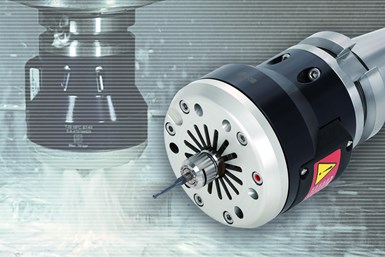Tungaloy HPC SpinJet High-Speed Spindle Driven by Coolant
High-Speed spindle line utilizes a CNC machine’s existing through-spindle coolant supply as a pressurized power source, eliminating the cost and need of external air or electric power supplies

Tungaloy HPC SpinJet
Tungaloy has expanded its SpinJet coolant-driven, auxiliary high-speed spindle series with the HPC SpinJet line which utilizes coolant pressures of up to 7 MPa (70 bar, 1,015 psi). It ramps up rpm for small cutters with higher coolant pressure.
The SpinJet is said to be easily adaptable to the spindle of existing CNC machines and provides instant enhancements in machining performance using small-diameter cutting tools. No additional machine purchase or modifications are required. The SpinJet utilizes the machine’s existing through-spindle coolant supply as a pressurized power source to drive the internal turbine for cutting tool rotation, thereby eliminating the cost and need of external air or electric power supplies. This feature gives the SpinJet a compact design, enabling it to be stored in a machine’s automatic toolchanger or tool magazine when it is not being used and it is installed on the main spindle as with any other standard tool.
The SpinJet includes a wireless display monitor which gives operators real-time performance of rpm for optimal cutting tool conditions according to actual rotational speed on the workpiece. The HPC SpinJet harnesses higher coolant pressures in a range of 4 to 7 MPa (40-70 bar, 580-1,015 psi), rotating the turbine as fast as 45,000 rpm. With enhanced internal turbine and bearings for higher torque output, the HPC SpinJet can handle various rotating tools up to 3 mm in diameter. HPC SpinJet boosts productivity when compared with conventional spindle setups. It also eliminates the need for workpiece transfer, thereby keeping the process chain intact for better machine downtime and operation efficiency.
Related Content
-
Making Micro Threads
Production of micro threads can be challenging, but using the most suitable tools for a given application can simplify the task.
-
Replaceable-Insert Spade Drill Basics, Advantages
Although solid carbide and indexable-insert drills have their place in a machine shop, replaceable-insert spade drills offer specific advantages for various holemaking operations on machining centers and lathes.
-
Data Matrix Codes Offer Cutting Tool Traceability
A company’s quest to discover errors in a manufacturing process has led to printing data matrix codes on its cutting tools that provide a wealth of information for both the user and this cutting tool manufacturer.












